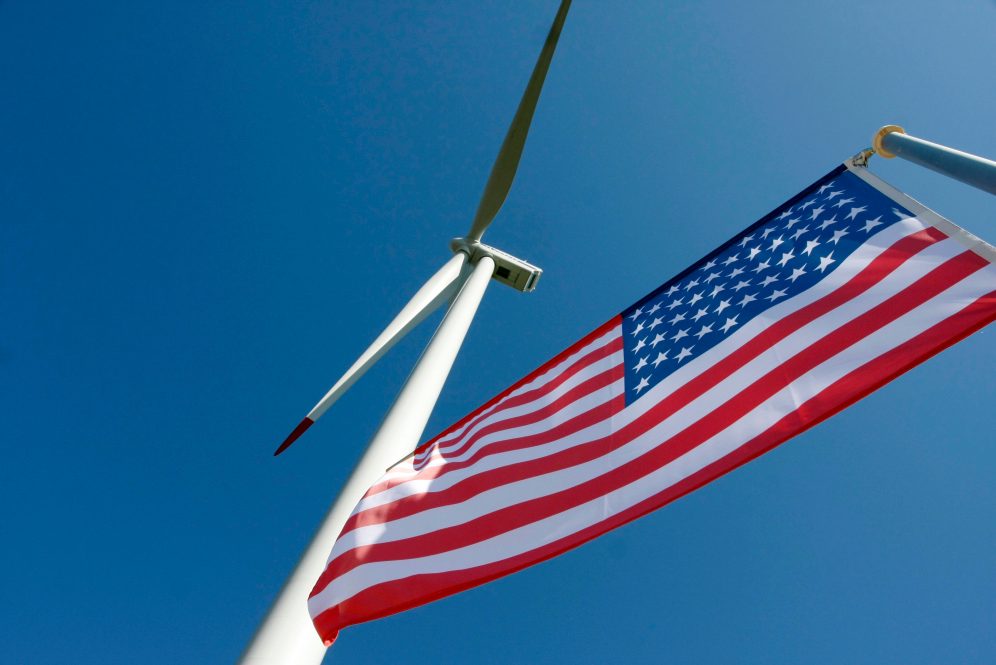In order to meet its goals under the Paris Agreement to sharply reduce carbon emissions, the U.S. would need to make a swift transition away from fossil fuels toward renewable energy. A number of political and procedural obstacles make this easier said than done, however.
One of the hurdles most commonly cited is elected officials’ fear of paying a political price for supporting clean energy projects. According to new research, though, this might be more perception than reality: both Republicans and Democrats can benefit politically from supporting wind energy projects.
This is the conclusion reached by Associate Professor of Political Science Oksan Bayulgen, Professor of Geography Carol Atkinson-Palombo, Mary Buchanan ’21 Ph.D., and Professor of Political Science Lyle Scruggs. Their findings were recently published in Energy Policy.
By studying elections in Minnesota between 2008 and 2018, the researchers found that wind turbine development has a positive impact on the electoral performance of incumbents, with the addition of at least one turbine within a precinct increasing the incumbent party’s vote by an average of between 1.8 and 9 percentage points. Minnesota was chosen because it’s one of the U.S. states where wind turbine developments are most common.
This should be good news for the advocates of renewable energy. There are many challenges associated with transitioning to clean energy, says Bayulgen, and it can only succeed if the infrastructure is socially accepted and politically rewarding for politicians who promote it.
“It’s important that we understand how voters behave, so we looked at incumbent vote share and how that changed from one election to another,” Bayulgen says.
Scruggs explains that many of the areas of the country best suited for wind energy projects are situated in Republican-dominated states, and in more Republican regions of Democratic-dominated states. He notes that though renewable energy is now cost-competitive with fossil fuel energy, political polarization is increasingly problematic for advocates of renewables.
“In the last few years, we’ve noticed increasing polarization on the acceptability of renewable energy,” Scruggs says. “There’s more local resistance generally. One of the important elements of the study is this question about how polarization affects the nation’s ability to expand renewable energy. If there’s more resistance in these places, it may limit the speed with which we can build out a renewable energy infrastructure.”
Atkinson-Palombo says the research design was important, and required a lot of mapping of the wind turbines which are spatially concentrated in swathes of wind farms in remote areas.
“We spent a lot of time discussing the research design and operationalizing the methodology to the smallest spatial scale that we could to pick up the locational impacts,” Atkinson-Palombo says. “The precinct is the spatial unit that we looked at for voting, and it’s the smallest one that we could possibly get. The rationale behind that is there are physical or material impacts from wind turbines, and it’s likely that the people who are closest to them are the ones who are going to have more of reaction to it.”
Bayulgen says, “Though understudied, this topic has huge implications for the feasibility of clean energy transition. If politicians are punished for building turbines in their jurisdiction, then they will be less inclined to pursue these projects again in the future, but if their vote shares increase from one election to another because they helped build these turbines, then they will continue to support these projects.”
This study is a starting point for the researchers, and proposals are in the works to expand and replicate the research to a further 23 states, and to also look at public opinion aspects at play in voter decision making. The researchers are hopeful they will see similar trends in other regions.
“One of the challenges is the data are not standardized across states, so we’re going to have to do a lot of legwork to get all of those datasets consistent,” says Atkinson-Palombo.
Much of the media attention is on national politics, but the researchers argue that, at least that in this instance, what’s most important happens at the local or state level.
Scruggs says it is important to find out if opposition is just political theater, or if people in these regions, particularly Republicans, really think it is a bad idea to develop renewable resources.
“For those of us who might be inclined to roll our eyes, we need to understand if and why people are resisting wind farm development in the middle of the country,” Scruggs says. “We’re going to need the expansive parts of the country to be on board with developing renewable resources, or it’s going to be challenging to do it in time to meaningfully address climate change.”
This was a UConn-funded Research Excellence Program project.



